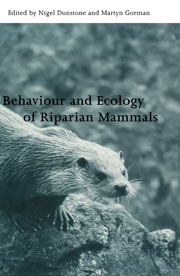Book contents
- Frontmatter
- Contents
- List of contributors
- Preface
- 1 Adaptations to the semi-aquatic habit and habitat
- 2 Physiological challenges in semi-aquatic mammals: swimming against the energetic tide
- 3 Diving capacity and foraging behaviour of the water shrew (Neomys fodiens)
- 4 Habitat use by water shrews, the smallest of amphibious mammals
- 5 The importance of the riparian environment as a habitat for British bats
- 6 A preliminary study of the behaviour of the European mink Mustela lutreola in Spain, by means of radiotracking
- 7 The demography of European otters Lutra lutra
- 8 Habitat use and conservation of otters (Lutra lutra) in Britain: a review
- 9 The relationship between riverbank habitat and prey availability and the distribution of otter (Lutra lutra) signs: an analysis using a geographical information system
- 10 Influence of altitude on the distribution, abundance and ecology of the otter (Lutra lutra)
- 11 Diets of semi-aquatic carnivores in northern Belarus, with implications for population changes
- 12 Otter (Lutra lutra) prey selection in relation to fish abundance and community structure in two different freshwater habitats
- 13 Diet, foraging behaviour and coexistence of African otters and the water mongoose
- 14 Feeding ecology of the smooth-coated otter Lutra perspicillata in the National Chambal Sanctuary, India
- 15 Population trends of hippopotami in the rivers of the Kruger National Park, South Africa
- 16 Reproductive strategies of female capybaras: dry-season gestation
- 17 The continuing decline of the European mink Mustela lutreola: evidence for the intraguild aggression hypothesis
- 18 Otters and pollution in Spain
- 19 The rapid impact of resident American mink on water voles: case studies in lowland England
- 20 Status, habitat use and conservation of giant otter in Peru
- Index
18 - Otters and pollution in Spain
Published online by Cambridge University Press: 03 May 2010
- Frontmatter
- Contents
- List of contributors
- Preface
- 1 Adaptations to the semi-aquatic habit and habitat
- 2 Physiological challenges in semi-aquatic mammals: swimming against the energetic tide
- 3 Diving capacity and foraging behaviour of the water shrew (Neomys fodiens)
- 4 Habitat use by water shrews, the smallest of amphibious mammals
- 5 The importance of the riparian environment as a habitat for British bats
- 6 A preliminary study of the behaviour of the European mink Mustela lutreola in Spain, by means of radiotracking
- 7 The demography of European otters Lutra lutra
- 8 Habitat use and conservation of otters (Lutra lutra) in Britain: a review
- 9 The relationship between riverbank habitat and prey availability and the distribution of otter (Lutra lutra) signs: an analysis using a geographical information system
- 10 Influence of altitude on the distribution, abundance and ecology of the otter (Lutra lutra)
- 11 Diets of semi-aquatic carnivores in northern Belarus, with implications for population changes
- 12 Otter (Lutra lutra) prey selection in relation to fish abundance and community structure in two different freshwater habitats
- 13 Diet, foraging behaviour and coexistence of African otters and the water mongoose
- 14 Feeding ecology of the smooth-coated otter Lutra perspicillata in the National Chambal Sanctuary, India
- 15 Population trends of hippopotami in the rivers of the Kruger National Park, South Africa
- 16 Reproductive strategies of female capybaras: dry-season gestation
- 17 The continuing decline of the European mink Mustela lutreola: evidence for the intraguild aggression hypothesis
- 18 Otters and pollution in Spain
- 19 The rapid impact of resident American mink on water voles: case studies in lowland England
- 20 Status, habitat use and conservation of giant otter in Peru
- Index
Summary
Introduction
Throughout the present century, several species of otter have suffered a significant decline in their numbers, frequently due to direct persecution, hunting and the destruction of their habitat (Foster–Turley et al, 1990). However, where populations have declined in the absence of these causes, contamination is thought to be involved and has been extensively demonstrated in Lutra lutra (Mason & Macdonald, 1986; Mason, 1989; Macdonald & Mason, 1994).
Those compounds that are accumulated in the organism through the food chain, reaching high levels in predators, have been specially studied. As well as affecting the mustelid directly, such components can also have an impact on prey, leading to a scarcity of food (Mason, 1989).
Amongst the compounds that are biomagnified, special attention has been paid to organochlorines (polychlorinated biphenyls (PCB), tetradichlordietan DDT, cyclodienes), being those on which most studies have been carried out (Mason, 1989; Olsson & Sandegren, 1991a,b; Smit et al, 1994). Amongst the most notable effects, besides death when the compounds are present in high concentrations, are the faults found in reproduction and the immune system, alterations in the nervous system, with changes in behaviour, and malformations (Mason, 1989; McBee & Bickham, 1990; Kihlstrom et al, 1992). Several of these effects have been found in Lutra lutra (Keymer et al, 1988; Mason & O'Sullivan, 1992).
- Type
- Chapter
- Information
- Behaviour and Ecology of Riparian Mammals , pp. 325 - 338Publisher: Cambridge University PressPrint publication year: 1998



